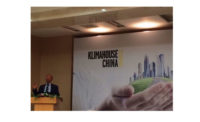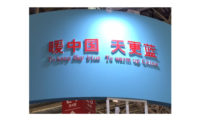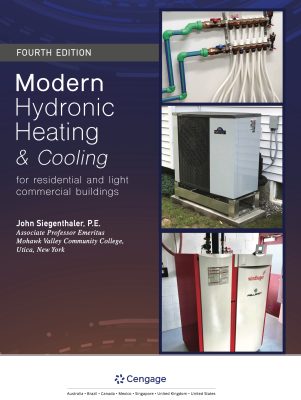ISH China trade show shifts focus to smart green buildings
‘To keep Sky blue, To warm up China’

Grundfos strikes a green theme in its booth as visitors examine products during the ISH China/CIHE Expo May 30-June 1 in Beijing. Photo credit: Bob Miodonski/Supply House Times.

Navien emphasizes its energy-efficient products in its booth at ISH China/CIHE.Photo credit: Bob Miodonski/Supply House Times.


The ISH China/CIHE trade show has grown bigger and smarter in recent years. Held May 30 through June 1 in Beijing, the 2016 version was bigger because the trade show filled all eight halls of the New China International Exhibition Center for the first time. Smarter because the products exhibited this year focused more on intelligent building technology.
ISH China celebrated its 20th anniversary in 2016. Both descriptions of bigger and smarter mentioned above represent huge leaps from where the show started in 1996. The show attracted 180 exhibitors that year vs. 1,128 in 2016 and the emphasis 20 years ago was on big boilers and big burners. The challenge then was to convert coal-fired heating equipment to products powered by natural gas.
What has not changed over the years is the emphasis on innovative HVAC and plumbing solutions.
“From the beginning, the emphasis has been on energy efficiency,” noted Andreas Lucke, general executive manager of BDH – Federation of German Heating Industry, during an opening ceremony. He and a Chinese citizen were the only two people at the ceremony who had attended the first ISH China 20 years ago.
Spurring on the talk of smart technologies is the acute air pollution in Beijing and other Chinese cities. The headline of this article comes from wording on an exhibitor’s booth on the trade-show floor and captures in a few words the environmental challenge China faces.
“Emissions and haze issues are the top two environmental concerns of the Chinese government,” said Allen Liang of another exhibitor, Midea Group.
The Chinese government’s beefed-up policies to promote energy-efficient technologies that utilize renewable energy sources helped boost ISH China/CIHE attendance this year, show producers said. This year’s show attracted a record number of 52,128 attendees.
Greater government investment to construct affordable green housing and public buildings has enhanced the market for energy-efficient products. Recognizing this growth, German and Italian manufacturers increased their booth space at this year’s trade show to display European technologies.
Products from Asian, European and even North American manufacturers included controls, robotics and smart thermostats. Among the brands familiar to U.S. contractors, engineers, distributors and manufacturers reps were: A. O. Smith, Watts Water Technologies, Reliance Worldwide, Navien, Grundfos, Rheem, Caleffi, Aquatherm, Raypak, Rinnai, Siemens, Pentair, Honeywell, REHAU and WILO.
Along with the trade show, the event presented the second China International HVAC Congress where energy efficiency was an important topic of discussion among the 400 attendees. The growing emphasis on intelligent HVAC technologies is evident in forum topics such as “How Smart Home Technologies Benefit the Development of Intelligent HVAC Solutions.”
Green building occupants
Another event presented concurrently with ISH China/CIHE was the Klimahouse China Congress. Founded in 2005, Klimahouse’s objectives are to promote innovative construction that reduces energy consumption, is economically profitable, is environmentally friendly, instills a sense of well-being and promotes an international culture of sustainability.
Klimahouse has produced touring trade shows in Italy since 2008, targeting technologies such as plumbing and HVAC, controls and measurement systems and renewable energies. This year marks the first time Klimahouse co-located with the Beijing event.
Speakers at the Klimahouse China Congress argued that while much of the focus in green construction has been on energy- and water-efficient technologies, more attention should be paid to a building’s envelope and its human occupants.
“Green building is not just technical; we need to take a human-based approach and see how construction can serve their needs,” Italian architect Massimo Rojsaid. “The end users — the people who live in the building — are the focus of this process. We need a holistic approach in architecture for green buildings. We need a different mindset.”
Roj, CEO of the Progetto CMR Global architectural firm, pointed out 54% of today’s population lives in urban areas that consume two-thirds of the world’s energy. In China, 47% of overall energy usage comes from the building industry and related energy consumption.
Saying architects must utilize “Less Ego, More Eco” (also the title of his book) in their designs, Roj emphasized the importance of green buildings. The environmental benefits, however, rank third behind the human and financial benefits of green buildings.
The financial benefits include increased productivity and efficiency of people working in green buildings, said Thomas Mur, CEO of Bolzano Exhibition Centre in Italy. Green buildings sell at prices up to 30% higher and rent at rates up to 24% higher than other buildings.
Green buildings can reduce energy consumption by 18% to 50%, water consumption by 20% to 50% and waste production by up to 70%, he said.
“Green technologies and the building’s casing must come together,” Mur said. “It’s not just the technologies.”
The envelope — or casing — encompasses a building’s roof and roofing products, insulation, walls and ceilings, doors and gates and window glazing. It also covers prefabricated housing and building materials, which may not be good news for U.S. plumbing contractors who have seen a growing trend toward prefabbed — or pod — bathrooms in hospitals, hotels and other buildings.
China adopted its first green building standard in 2006, effective in 2008. The government addressed some of the deficiencies in the standard in 2011 with an amended new standard instituted in 2014.
“The standard has been improved constantly and now covers all public and commercial buildings in China,” said Li Hong Jun, a senior engineer in the Green Building Sector of the Ministry of Housing and Urban-Rural Development. “We need special standards in the future for different categories such as schools, restaurants and high-rises.”
The Chinese government plans to increase the percentage of green buildings constructed in China from 1% in 2012 to more than 25% in 2020. Additional incentives to encourage more green buildings include tax benefits, special financial services for buyers of residential green buildings and adjustments in land policies for green building projects.
ISH China is an offshoot of the better known ISH in Germany, produced every other year by Messe Frankfurt. Several years ago, ISH China merged with CIHE, produced by Beijing B&D Tiger Exhibition Co. ISH China/CIHE 2017 will take place May 18-20 in Beijing.
This article was originally titled “‘To keep sky blue, To warm up China’” in the August 2016 print edition of Supply House Times.
Looking for a reprint of this article?
From high-res PDFs to custom plaques, order your copy today!









